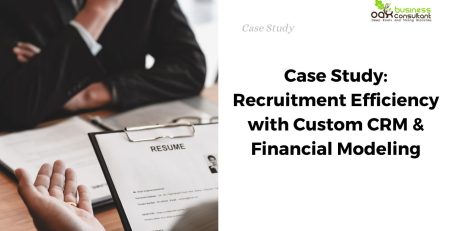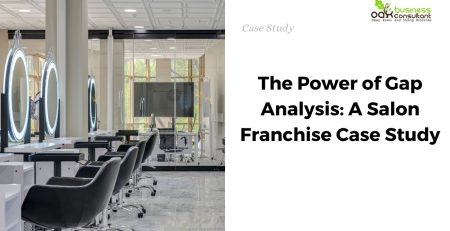Case Study: Optimizing Recruitment Industry Pricing Strategy
Client Overview
This case study highlights the development of a comprehensive pricing strategy for a new entrant in the recruitment industry. The client’s primary objective was to create a structured pricing model for a platform designed to connect consultants with companies for job placements. To address this need, we developed a recruitment industry pricing strategy that ensures accessibility and ease of adoption during the initial growth phase. Additionally, we explored future pricing options to facilitate business diversification and expansion. These strategies position the company for scalable growth by addressing market gaps with flexible hiring solutions and sustainable revenue streams.
Challenges of Client
- Lack of Structured Pricing Model – Difficulty in determining appropriate pricing for services, leading to potential revenue inconsistencies.
- Cost Structure Uncertainty – Limited visibility into operational costs, impacting profitability and pricing decisions.
- Competitive Pricing Analysis – Difficulty in benchmarking against competitors due to variations in pricing models and market positioning.
- Market Size Estimation – Challenges in accurately assessing the TAM, SAM, and SOM for the UAE and GCC region to support strategic decision-making.
- Regulatory and Economic Factors – Navigating region-specific labor laws, economic conditions, and demand fluctuations affecting recruitment services.
Solutions Provided
We developed a comprehensive recruitment industry pricing strategy tailored to accommodate businesses of all sizes and hiring needs. Our approach included market size estimation for the UAE and GCC regions, an in-depth competitor analysis, and the creation of a detailed cost analysis template. Additionally, we designed future pricing strategies to support the company’s expansion, ensuring long-term scalability and profitability. This strategic framework equips the client with a structured and competitive pricing model, reinforcing Oak Business Consultant’s commitment to delivering impactful, results-driven solutions.
Key Features of the Recruitment Industry Pricing Strategy for Our Client

1. Structured and Flexible Pricing Models for Recruitment Services
Our primary focus was to create a structured and adaptable pricing model tailored to the client’s diverse recruitment services. The model was designed to cater to a wide variety of recruitment needs, offering flexibility in pricing structures. Key elements of this strategy include Retainer Fees, Placement Fees, and Hourly Rates. This mixed approach provides clients with scalable solutions, whether they need contract staffing, specialized talent acquisition, or entry-level placements. By combining retainer-based fees, placement fees, and hourly rates, we ensured the pricing model was dynamic. This approach met the needs of companies across industries. Whether they were hiring for permanent positions, temporary roles, or specific talent pools, the model was flexible and adaptable.
2. Contingency-Based Recruitment (Success-Based Fees)
Under the contingency-based recruitment model, fees are only charged upon a successful placement. Typically, the placement fee is calculated as a percentage of the candidate’s first-year salary, usually ranging from 15-20%. This model works well for client looking for flexible, low-risk recruitment options where fees are earned only when a candidate is successfully placed, ensuring alignment with the client’s hiring objectives.
3. Hourly and Flat Rate Models for Short-Term Projects
The hourly rate and flat-rate pricing models are ideal for businesses seeking short-term, specific project-based recruitment or freelance recruiting services. These models provide clear cost structures. They allow companies to maintain budget control while addressing unique, short-term hiring needs, such as temporary assignments or seasonal work.
Cost Analysis Template for Optimizing Recruitment Operations
To optimize the client’s recruitment pricing and operational efficiency, we developed a Cost Analysis Template. This comprehensive tool enabled the client to:
- Track Recruitment-Related Costs: This includes agency fees, candidate assessments, background checks, and any additional costs related to candidate sourcing, ensuring transparency in all recruitment processes.
- Monitor Overhead and Operational Costs: The template also accounted for overhead costs such as office expenses, marketing, recruitment software, and recruiter salaries, giving a holistic view of the financial landscape.
- Account for Additional Recruitment Costs: We tracked expenses like advertising, consultant commissions, and job board fees to ensure more accurate pricing adjustments.
This cost structure analysis provided the client with insights into their profit margins, helping them ensure their recruitment pricing remained competitive and profitable while also staying aligned with market trends and internal financial goals.
Competitor Analysis and Market Benchmarking for Recruitment Agencies
A pivotal aspect of the recruitment pricing strategy was the competitor analysis within the UAE and GCC recruitment markets. This analysis provided the following insights:
- Industry Benchmarking: By studying pricing models of competing recruitment firms, we identified key industry benchmarks such as placement fees, retainer models, and success-based compensation structures. This benchmarking allowed us to position the client’s pricing within industry standards while highlighting their unique selling points.
- Differentiation through Specialized Recruitment Services: The client could leverage its expertise in recruiting for niche talent pools, offering tailored solutions for specialized positions and hard-to-fill roles.This differentiation strategy gave them a competitive edge by targeting high-demand talent that others ignored.
- Competitive Fee Structures: By analyzing competitor models, we identified ways to offer flexible recruitment pricing that caters to different client needs, from contingency recruitment to exclusive search models. This pricing flexibility allowed the client to offer tailored solutions based on client needs and commitment levels.
Market Size Estimation (TAM, SAM, SOM) for Recruitment Growth
To enhance the pricing strategy, we employed market size estimation using the Total Addressable Market (TAM), Serviceable Available Market (SAM), and Serviceable Obtainable Market (SOM) models. This analysis provided insights into the broader market dynamics and helped optimize the recruitment pricing structure:
- Demand for Specialized Roles: We assessed the demand for specialized roles, particularly within the UAE and GCC recruitment industry. These roles, such as senior executives, technical talent, and niche specialists, directly impacted the placement fee structure and helped tailor recruitment packages for these high-demand positions.
- Growth of Contract and Temporary Employment Markets: We identified a growing demand for contract placements and temporary workers, prompting the introduction of flexible pricing models to cater to businesses seeking non-permanent staff solutions. This market insight drove the pricing strategy to be more agile and adaptive to short-term staffing needs.
- Impact of Salary Trends: The market dynamics analysis helped understand the salary levels across different sectors, which influenced placement fee percentages and helped ensure the pricing structure remained competitive and aligned with regional pay trends.
These market insights allowed us to adjust the pricing model to match regional demands while maximizing profitability.
Ongoing Support and Iterative Refinement of Recruitment Pricing
To ensure long-term competitiveness, we integrated an ongoing support system that provided the client with continuous access to updates and refinements for their pricing strategy. Key components of this iterative approach included:
- Continuous Feedback and Market Adjustment: We established regular communication with the client to assess recruitment market shifts, trends, and evolving client needs. This feedback loop allowed for timely adjustments to the pricing model, ensuring it remained aligned with market conditions.
- Agile Pricing Strategy: By maintaining an agile approach, the pricing model could be continuously refined based on digital recruitment trends, employee retention strategies, talent pool dynamics, and client expectations. This ensured the client’s pricing structure was always competitive and adaptable to changing industry conditions.
This iterative process ensured that the client’s recruitment strategy remained responsive to market shifts, maintaining a competitive advantage in an ever-changing recruitment landscape.
Results
As the client begins implementing the comprehensive pricing strategy, they are experiencing several key benefits:
- Strategic Alignment: The pricing structure is tailored to support business scalability and adaptability in a competitive market.
- Market Insight: Data-driven decision-making capabilities have been enhanced, enabling more effective business planning.
- Competitive Positioning: A structured pricing model strengthens the company’s value proposition in the recruitment industry.
Through this tailored and in-depth pricing strategy, Oak Business Consultant has empowered the client to pursue their business objectives with confidence and clarity.
What’s in It for You?
As a recruitment agency owner, HR director, or talent acquisition leader, you know how crucial it is to establish a clear and competitive pricing strategy in a fast-paced industry. Without a structured pricing model, your business may face:
- Revenue Inconsistencies: Unstable cash flow due to ineffective pricing, impacting your ability to invest in growth.
- Operational Inefficiencies: Poor cost visibility and management leading to lower profit margins and resource misallocation.
- Competitive Pressure: Difficulty differentiating from established agencies with structured, transparent fee models.
- Scaling Challenges: Inability to forecast market dynamics (TAM, SAM, SOM) and meet investor expectations for expansion.
- Client Trust Issues: Unclear pricing structures that can undermine client confidence and long-term relationships.
How Can You Overcome These Challenges?
Here are proven strategies to help you transform these obstacles into opportunities for growth:
- Achieve Predictable Revenue: Implement a structured pricing strategy that combines contingency fees, retainer models, and hourly rates, ensuring revenue stability.
- Optimize Cost Management: Utilize a comprehensive cost analysis template to track recruitment-related costs and enhance operational efficiency.
- Enhance Competitive Positioning: Leverage in-depth competitor analysis and market benchmarking to offer flexible, market-aligned pricing.
- Secure Long-Term Growth: Use data-driven market size estimation to tailor pricing models for scalable expansion in the UAE and GCC regions.
- Build Client Trust: Offer transparent and adaptable pricing models that meet diverse hiring needs, fostering stronger client relationships.
Ready to Transform Your Recruitment Business?
At Oak Business Consultant, we specialize in financial modeling, business planning, and market strategy tailored for the recruitment industry. Book a free consultation today, and let’s develop a customized pricing strategy that positions your business for sustainable growth and competitive success!
Frequently Asked Questions
What factors influence recruitment pricing?
Key factors include candidate’s first-year salary, position level (entry-level, senior roles, or C-suite), hiring process complexity, and recruitment model (contingency, retainer, hourly, or flat rate).
What are common recruitment fee structures?
- Contingency Fees: Paid upon a successful hire, typically 15-20% of the first-year salary.
- Retainer Fees: Upfront commitment for exclusive recruitment, ideal for senior roles.
- Hourly/Flat Rates: Used for temporary placements or short-term hiring needs.
- Performance-Based: Fees tied to hiring outcomes with possible placement guarantees.
How do percentage-based fees work?
Fees are a percentage of the employee’s first-year salary, ensuring agencies are compensated for securing quality candidates.
What’s the difference between contingency and retainer models?
- Contingency: Payment only after a successful hire, suitable for a wide range of roles.
- Retainer: Upfront payment for an exclusive search, ideal for C-suite or specialized roles.
Are additional charges included?
Some agencies charge for background checks, job ads, relocation services, or passive candidate sourcing.
How do agencies handle temporary and contract employees?
Daily rate or markup multipliers are used for temporary and contract placements, ensuring cost efficiency and predictable revenue.
What makes a recruitment agency’s pricing competitive?
A balanced fee structure combining fair pricing, market benchmarks, and flexibility for employers while ensuring client satisfaction and quality hires.
Conclusion
This comprehensive and dynamic pricing strategy ensured that our client’s recruitment business remained flexible, competitive, and profitable. By leveraging a diverse pricing structure, conducting competitor analysis, estimating market potential, and providing ongoing support, we helped the client successfully navigate the recruitment industry’s competitive landscape and capitalize on emerging trends in the UAE and GCC regions.Ready to Elevate Your Recruitment Business? Book your free consultation with Oak Business Consultant today and discover how our tailored pricing strategies can drive scalable growth, enhance client trust, and secure your competitive edge in the market.



























